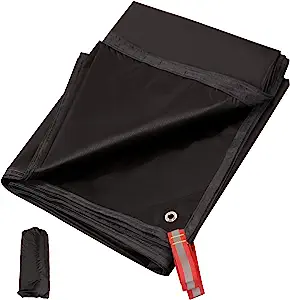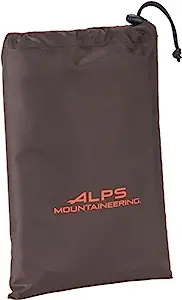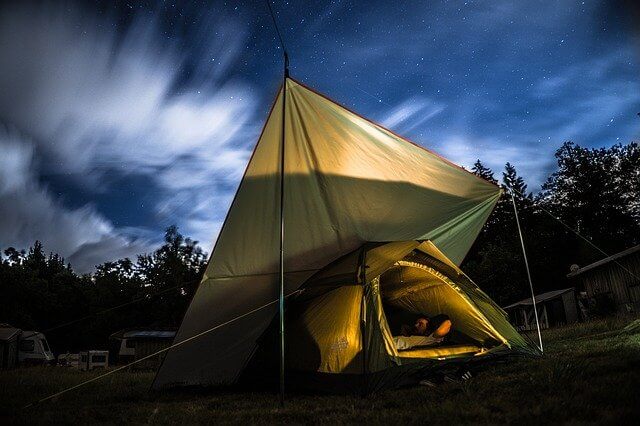I know most of us have heard about it, but not all of us know what it is. This is why we are here to tell you why, how, and whether you can use a tent footprint when camping.
What is a Footprint For a Tent
Every backpacker and camper needs to know what a tent footprint is, and that is why we have prepared this guide that will tell you all you need to know about it. Of course, not all people need a footprint, but they do need to know what it is used for. Once you know its purpose, you can decide for yourself whether you do or don’t need one. Now, we will tell you what a tent footprint is.
A tent footprint is a separate piece of gear that one uses as a barrier between the tent floor and the ground. A tent footprint isn’t the same as a tent floor. It is a separate type of tarp.
As you might figure yourself, it is used as a barrier between the tent and the ground. Most people use this because they want a separate piece of gear that will protect them from the ground. But why do they need protection? Because the floor can be dirty, wet, or have bugs and animals inside of it. That is why most people use an extra footprint that helps you clean your tent floor more easily.
Do You Need a Tent Footprint?
Tent footprints are not essential to camping but are recommended. If you own an ultralight tent with a low denier floor, invest in a footprint or create one yourself. By adding a footprint underneath your tent, you introduce an extra layer that slightly elevates you from the ground.
This elevation helps minimize heat loss to the ground. To determine whether your tent requires a footprint, consider three key factors. Firstly, examine the material of your tent floor. Secondly, assess its thickness. Finally, take into account the ground conditions at your camping location.
Using a tent footprint offers several advantages:
- Protects your tent floor from damage: The additional layer acts as a shield, safeguarding your tent floor against potential harm caused by rough or sharp objects on the ground.
- Keeps the underside of your tent floor clean: By using a footprint, you prevent dirt, mud, and other debris from accumulating underneath your tent. This ensures that you don’t end up with a soiled and messy tent.
- Keeps the underside of your tent floor dry: A footprint acts as a barrier, preventing moisture from seeping through the ground and reaching the bottom of your tent. This helps maintain a dry and comfortable interior.
- Easier to clean: When it’s time to clean your tent, having a separate footprint makes the task more convenient. You can easily detach and clean the footprint, simplifying the overall maintenance process.
Therefore, you yourself need to decide whether you need a tent footprint or not. This especially goes for backpackers who don’t have all the place in the world, and adding a footprint might add to their bulk.
Best Tent Footprints And Tarps
Following are the best tent footprints and tarps available in the market.
| Tent footprint | Price |
| REDCAMP Ultralight Tent Footprint | Price on Amazon |
| Frelaxy Tent Tarp | Price on Amazon |
| Clostnature Footprint | Price on Amazon |
| Terra Hiker Camping Tarp | Price on Amazon |
| ALPS Mountaineering Lynx 1 Footprint | Price on Amazon |
| Wise Owl Outfitters Hammock Tarp | Price on Amazon |
| Marmot Footprint for Crane Creek Tent | Price on Amazon |
| OneTigris Waterproof Tent Footprint | Price on Amazon |
| Nemo Footprint for Dragonfly Tent | Price on Amazon |
1. REDCAMP Ultralight Tent Footprint

The REDCAMP Ultralight Tent Footprint is an excellent all-around footprint that does the job brilliantly. Works fine when used both as a tarp or footprint with less weight and is even easier to carry in a backpack. This material offers some of the best water resistance while remaining lightweight and durable. While the polyester material is light and strong, It’s also incredibly compact, weighing 258g, perfect for backpacking.
It has hooks for attaching stakes for a sturdy grip under the tent.
2. Clostnature Footprint
If you are looking for an excellent waterproof yet budget-friendly footprint, look no further than Clostnature Tent Footprint. Among the many best footprints, this takes edge due to the quality and protection from the ground. The Clostnature Tent Footprint held up to every outdoor adventure we threw at it, as well as camping in some terrible weather and locations.
3. ALPS Mountaineering Lynx Footprint
At 8 ounces(single person), the ALPS Mountaineering is one of the lightest tent footprints we have found, and it does pack down small and compact. It’s also reasonably priced, especially the one-person footprint but three-person are much broader and more significant, meant for more giant tents.

Keep the tent clean and secure from scratches, wear, and tears with a budget-friendly price tag. The setup of this footprint is straightforward without any technical details. However, this size might be short for a giant one-person tent, and it might not extend a little bit in addition to the size of the tent.
4. Wise Owl Outfitters Hammock Tarp
Wise Owl Outfitters Hammock Tarp is the perfect bad-weather protection tarp that can be used for both tent and a hammock. This heavy-duty, durable tarp with aluminum tent stakes and a waterproof design does not come with less weight, so be ready to carry additional ounces, but it’s worth it. This tarp keeps the hammock and tent safe and dry whether you’re facing rain, shine, or snow.
Furthermore, This is an excellent addition to any hammock setup. It’s quick and easy to set up, like ALPS Mountaineering Lynx 1 Footprint. The tarp has many uses – you can use it as a ground tarp for car camping or backpacking.
How Do You Use A Tent Footprint?
There are two main ways to use a footprint: a groundsheet on its own or a liner inside your tent.
If you use your footprint as a groundsheet, place it underneath your tent before pitching.
If you want to use your footprint as a liner:
- Pitch your tent as usual.
- Place the footprint inside the tent, on top of the floor. It’s better to have a tent footprint a little wider than the tent bottom to cover more area, so in this case, you need to carefully manage the extra footprint inside the tent.
- Once it’s in place, add your sleeping bags and other gear.
Tent Footprints Alternative
These are the most popular tent footprint alternatives:
- Plycro: The most popular ultralight groundsheets are made of two types of plastic: Polycryo and Tyvek home wrap.
- Window wrap: Window wrap plastic insulation is a great substitute for a tent footprint and weighs only 1.3 ounces. It can last for a season or longer, depending on use.
- Tyvek HomeWrap: It is heavier but more durable than window wrap. It’s lightweight, waterproof, and puncture-resistant, making it suitable as an ultralight groundsheet. It can last for multiple seasons due to its toughness.
Tent Footprint vs Tarp Comparison
Are tarps and tent footprints the same? The answer depends on the use of both. In most cases, a footprint is light and waterproof, while a tarp can be bulky and not always waterproof.
Now, let us look at more of these specifics. Tent footprints and tarps can both serve as protective layers for the bottom of a tent. While tent footprints can be costly, they are specifically designed to fit the shape of the tent and are lightweight, making them easier to carry. On the other hand, tarps are heavier and require customization, but they are more affordable, provide enhanced protection, and are highly durable.
Here is the key difference:
| Tent Footprint | Tarp |
| It protects the ends of the tent foot. | It protects the exterior of the tent (entire tent). |
| Tent footprint is a bit expensive. | The tent tarp is inexpensive. |
| Requires to be planted precisely. | Easy to set up. |
| Adds comfort. | Add comforts |
| Keeps the flooring dry. | Keeps entire tent dry. |
| Durable | Durable |
| Fragile if frequently used on uneven surface | Sturdy for exterior as well as interior |
| Light in weight | Light in weight |
| Made of plastic, tyvek, vinyl, rubber, etc. | Polyethylene |
Conclusion
In conclusion, if you need a tent footprint but want to save money or reduce backpack weight, consider using an alternative. The ones we listed need some elbow grease, but making an ultralight groundsheet using window wrap insulation or Tyvek is easy. In the end, for most of us, tarps and tailored tent footprints are too pricy. Still, for backpackers, they might even be too heavy or bulky. That is why a tested alternative like window wrap is the best bet.
In the end, each camper needs to know the pros and cons of a tent footprint, and only then should they decide if they need one in their ear set. Therefore, decide for yourself if a footprint is a thing you need or if a tarp or alternative material is the best for you.
Related:
